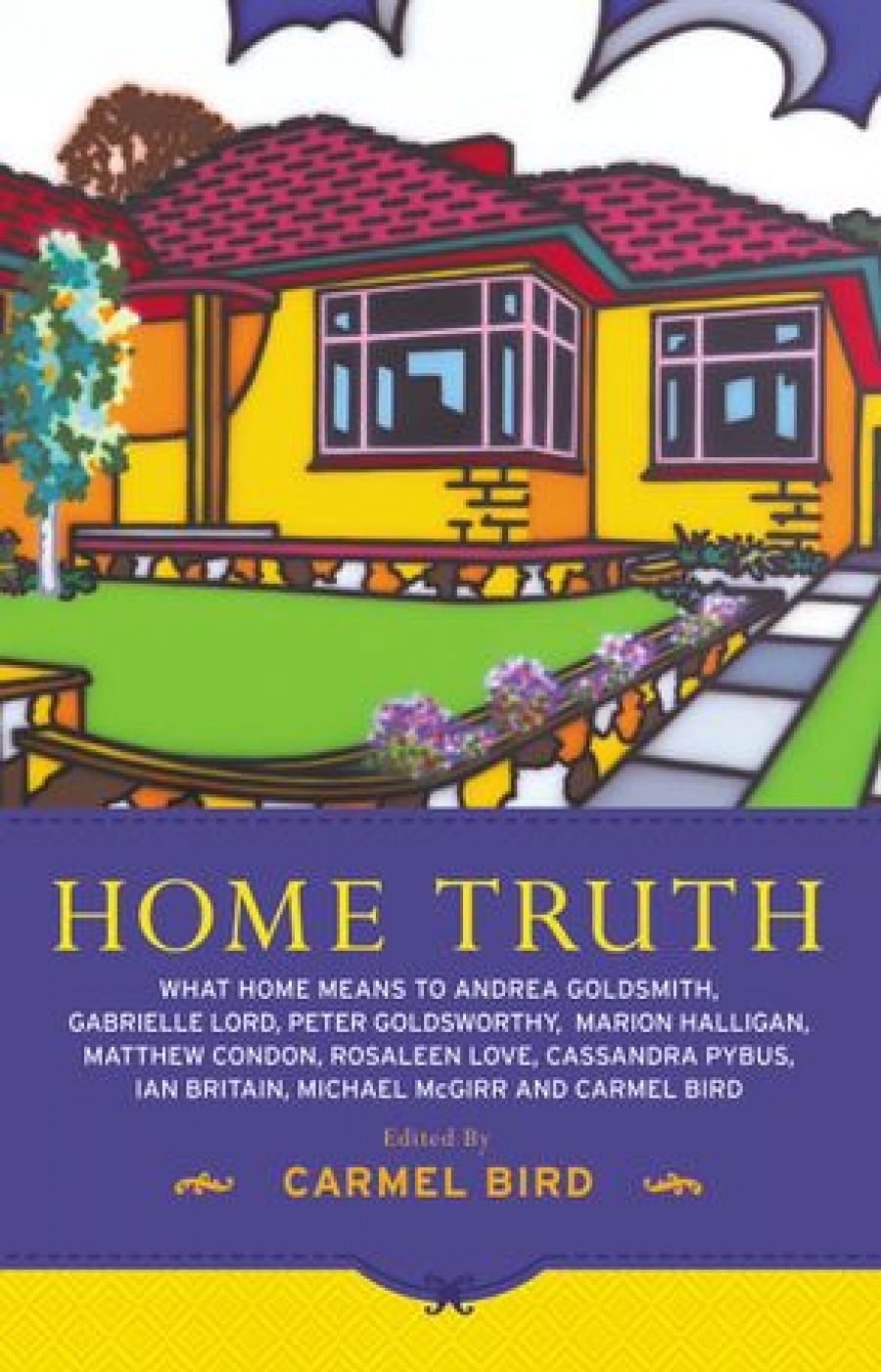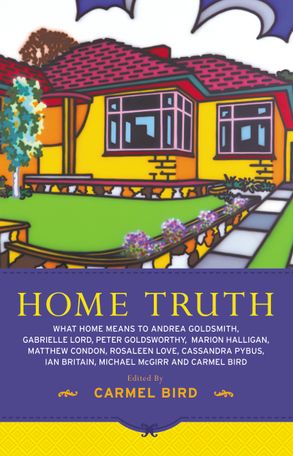
- Free Article: No
- Contents Category: Essay Collection
- Review Article: Yes
- Article Title: Plush embraces
- Online Only: No
- Custom Highlight Text:
We are often far / From home in a dark town’ writes Charlie Smith in his poem ‘The Meaning of Birds’. Home Truth explores dark towns both literal and figurative. The pieces in any anthology are jigsaw-like, forming an overarching image. In this case, it is a sense of home as an entity most powerfully felt in exile; the place we look to from our darkest places. In her perceptive essay, Carmel Bird, scrutinising her immediate thoughts about home, finds in them much that looks like ‘a series of clichés and stereotypes’. Concepts of home, she suggests, may be ‘tinged with the glow of nostalgia, shadowed by poignant reminders of the ideal past’. If this is the face of the anthology’s jigsaw, it proves palimpsestic. Its deeper vision is the idea of resilience and of making a home from a position of exile.
- Book 1 Title: Home Truth
- Book 1 Biblio: Fourth Estate, $29.99 pb, 304 pp
- Book 1 Cover Small (400 x 600):

In her posthumous essay On Passion (2010), Dorothy Porter foreshadows death’s ultimate exile. Less a moment of self-elegy than a complicated knot of erased prolepsis, Porter celebrates life and love with her partner, Andrea Goldsmith, even as she acknowledges the finite nature of that perfect moment of being at home: ‘One day I will die. One day I will not wake up to the smell of my partner bringing my morning mug of strong coffee up the stairs.’ In ‘Home Triptych’, Goldsmith writes about that image: ‘our morning ritual: me sitting cross-legged on the quilt, you still in bed … and here’s your coffee and here’s my second cup of coffee.’ Goldsmith quotes one of Porter’s last poems, which captures the sanctity of loving domestic ritual:
How lucky I am
to hear you, darling,
coming up the stairs
to smell the coffee
floating ahead of you
like my favourite incense.
The first part of ‘Home Triptych’ is addressed to ‘you’, but by its third section Porter has become ‘she’, and Goldsmith charts the terrible exile of a home without Porter, imbued with her presence and absence. In many ways, Goldsmith’s triptych is at the heart of the collection, for its evocation both of alienation – the way what we have called home may be drained of its warmth by loss or displacement – and resilience. An image of Goldsmith’s looking ‘up into vast space and [wondering] what is out there, [feeling] the temptation and danger of unknown and uncertain possibilities’ is followed by another of her preparing to ‘read my way home’. Perhaps the most exquisite images of this lyrical essay are those of the creativity of domesticity, such as the cooking that ‘fed our shared narrative’.
Marion Halligan’s ‘Distance Looks Our Way’ is another essay about resilience. Halligan’s craft has a deceptively simple surface, belying its rich textures and sensuality. She responds archly to the convenient pigeonhole into which her fiction is often pushed. Yes, she says, I write domestic novels. Their focus is not, however, ‘mis-plumbed washing machines’, but questions of birth, death, love. Does Australian literary culture continue to exile the domestic? And what does this mean for any writer who ventures there?
This question resonates with some of the anthology’s gender differences, with women writers tending towards more intimate versions of home. Matthew Condon’s interesting piece about the making of Brisbane’s history does not set foot in any domestic space, tracing instead broader implications of the city as home. Peter Goldsworthy’s memories of home include a sense of the sometimes mystifying world of his mother’s life, but focus on the kind of readerly homemaking that consoles Goldsmith and that Halligan threads through her essay. Ian Britain’s ‘This Plush Embrace’ explores the idea that the original home is the womb and that ‘nostalgia for pre-natal days’ is a more or less conscious drive. While the premise is not original, Britain’s exploration of it, via art and science, and texts from the biblical to the philosophical, is. His charting of imaginative exploration, with moments of doubt, hesitation and excitement, gives the piece its vitality. Besides discussing Judith Wright and Georgia O’Keeffe, Britain confines his exploration to male commentators on all things uterine. The work of women – especially, perhaps, mothers – may have added interesting layers to the discussion. Britain’s evocation of the ‘plush embrace’ of his bedroom provides a striking conclusion.
Britain’s piece exemplifies a quality of literary peregrination that runs through the anthology. Perhaps the genre encourages this; the etymological and generic pull of testing and trying. Rosaleen Love considers a lineage of exile, and what the song ‘Home Sweet Home’ might have meant, and may now mean to those who experience a ‘half-pleasurable, half-painful emotional reaction’ to its strains. While the organisation of Love’s essay around stories of her forebears and the song itself structures her piece, Gabrielle Lord’s essay is concerned with unpacking and destabilising certainty; a mostly productive pulling-apart of what nostalgia for home may conceal. Jerusalem, the body, poetry: Lord’s examination of exile is restlessly multifarious, yet her piece concludes with an image of mindfulness; a home within us that too much mobility and busyness might itself exile us from.
There is more here that is delightful and provocative, including Cassandra Pybus’s discovery of the soul’s search for home, and Bird’s captivating storytelling and wise observation (including a detour towards the uterine). The question of how we evaluate the much-disparaged domestic is made central.


Comments powered by CComment